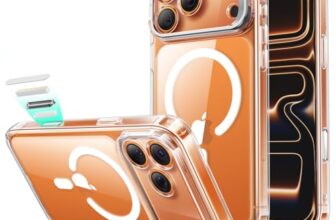The Modern Classic:Technical Benchmark of the Edifier R1280DB Bookshelf Speakers
In an audio market increasingly saturated with disposable smart speakers and bass-heavy soundbars, the demand for pure, high-fidelity, two-channel stereo sound has seen a remarkable resurgence. Discerning listeners are rediscovering the immersive and authentic audio experience that a well-engineered pair of bookshelf speakers can provide. However, the traditional path to hi-fi—requiring separate amplifiers, preamps, and a web of cables—can be both complex and costly. This is where the powered bookshelf speaker has emerged as the definitive solution for the modern audio enthusiast, integrating the amplifier and speakers into a single, elegant, and accessible package. Within this competitive category, few products have achieved the legendary status and enduring popularity of the Edifier R1280DB.
The Edifier R1280DB is not merely a product; it is a benchmark. For years, it has been the go-to recommendation for anyone seeking an entry point into the world of serious audio without breaking the bank. It represents a masterclass in value engineering, prioritizing core acoustic principles and versatile connectivity over superfluous features. It combines the warmth and detail of a traditional hi-fi system with the convenience of modern wireless and digital connections, making it a perfect audio hub for a desktop, a television, or a small-to-medium-sized listening room. As we move through 2025, its design and performance continue to make it a top contender against a sea of newer, often more compromised, competitors.
This review will serve as a deep technical analysis of the Edifier R1280DB. We will move beyond subjective praise to dissect the specific engineering choices that contribute to its celebrated sound quality. We will examine its acoustic design, from the materials of its drivers to the tuning of its bass reflex port. We will deconstruct its versatile connectivity suite, explaining the technical advantages of its digital inputs. Finally, we will evaluate its user interface and control scheme. This is a comprehensive benchmark intended to reveal the science and engineering that have cemented the R1280DB’s place as a modern classic and a top recommendation for anyone serious about sound in 2025.
Chapter 1: Acoustic Engineering and Driver Technology
The foundation of the R1280DB’s audio performance lies in its adherence to classic acoustic design principles. Edifier has focused its resources on the components that matter most: the cabinet, the drivers, and the internal amplification, resulting in a sound that is balanced, detailed, and remarkably composed for its size and price.
The Enclosure: A Foundation of Acoustic Inertia
The speaker cabinets are constructed from Medium-Density Fibreboard (MDF), a material universally favored in high-quality speaker design. Unlike solid wood, which has natural resonances and grains that can color the sound, MDF is an engineered wood composite that is exceptionally dense and acoustically inert. This density is crucial as it resists vibration and flexing. The cabinet’s job is to be a silent partner, allowing the drivers to produce sound without the enclosure itself vibrating and muddying the audio. The classic wood grain vinyl finish provides a timeless aesthetic that complements a variety of decors.
A key engineering choice is the inclusion of a front-facing bass reflex port on each speaker. A port is essentially a tuned tube that allows air to move in and out of the cabinet, reinforcing the low-frequency output of the woofer and making the bass sound fuller and deeper than it would in a sealed enclosure. By placing this port on the front, Edifier has made the R1280DB significantly more forgiving of placement. Rear-ported speakers need to be placed well away from walls to avoid the bass becoming boomy and indistinct. With front-porting, the R1280DB can be placed closer to a wall or on a bookshelf without a severe negative impact on its bass response, a massive practical advantage for users with limited space.
The Drivers: Reproducing the Full Spectrum
The R1280DB employs a classic two-way driver design, with a dedicated woofer for low and mid-range frequencies and a tweeter for high frequencies.
- 4-Inch Bass Driver: The 4-inch woofer is responsible for reproducing everything from the kick of a drum to the body of a human voice. The cone is likely constructed from a treated paper or poly-paper composite. While seemingly low-tech, paper has an excellent stiffness-to-mass ratio and superior internal damping, which allows it to reproduce midrange frequencies with a natural, uncolored timbre that is often preferred over stiffer but more resonant materials.
- 13mm Silk Dome Tweeter: This is arguably the star of the show and a key reason for the R1280DB’s refined sound. A tweeter’s job is to reproduce the highest frequencies—cymbals, strings, and vocal sibilance. The choice of a silk dome is significant. Silk is a lightweight and well-damped material. This allows it to respond to high-frequency signals with speed and accuracy, but its inherent damping properties help to control unwanted resonances or “break-up modes” that can make cheaper metal-dome tweeters sound harsh, brittle, or fatiguing. The result is a high-end that is detailed and airy, but also smooth and easy to listen to for extended periods.

The Power Plant: 42 Watts RMS Amplification
The R1280DB is a “powered” or “active” speaker system, meaning the amplifier is built directly into one of the speaker cabinets (the right speaker, in this case). The system is rated at 42 watts RMS. It’s important to understand what “RMS” (Root Mean Square) means. Unlike misleading “peak power” ratings, RMS represents the continuous, usable power the amplifier can deliver. With 21 watts RMS dedicated to each channel, the R1280DB has more than enough clean power to fill a small-to-medium-sized room and to provide an immersive near-field listening experience at a desk. The amplifier is likely a Class D design, which is highly efficient, generates very little heat, and is compact—all ideal characteristics for integration into a small speaker cabinet.
Chapter 2: The Versatile Connectivity Hub
A major strength of the R1280DB is its ability to serve as a central audio hub for a wide variety of sources, seamlessly bridging the gap between modern digital devices and traditional analog components.
Digital Inputs: The Path to Lossless Connection
The inclusion of digital inputs is what elevates the R1280DB above many of its competitors. It offers both an Optical (Toslink) and a Coaxial input. The technical advantage of these inputs is profound. When you connect a source like a modern television, a computer, or a gaming console via Optical or Coaxial, the audio signal travels from the source to the speaker as a pure digital stream of 1s and 0s. This digital signal is then converted into an analog sound wave by the speaker’s own internal Digital-to-Analog Converter (DAC). This process bypasses the often lower-quality DACs found in TVs and computer motherboards and avoids the analog cabling that can be susceptible to electrical interference and signal degradation. The result is a cleaner, clearer, and more detailed sound, which is why Edifier refers to it as a “lossless connection.”

Wireless and Analog Flexibility
- Bluetooth Wireless: For ultimate convenience, the R1280DB features a Bluetooth receiver, allowing for easy wireless audio streaming from a smartphone, tablet, or laptop. This is perfect for casual listening, podcasts, or when you want to quickly share a song with friends without the hassle of wires.
- Dual RCA Inputs: The speaker also includes two pairs of traditional analog RCA inputs. This allows for the connection of up to two line-level analog sources simultaneously. This is ideal for components like a CD player, a DAC, or a turntable (that has a built-in or external phono preamp). Having two separate inputs means you can keep multiple devices connected and switch between them using the remote control.
Chapter 3: User Interface and Ergonomic Control
Edifier has provided a simple yet effective control scheme that balances modern remote-controlled convenience with satisfying, tactile hands-on adjustment.
The Command Center: Side Panel Controls
Located in a recessed panel on the side of the active (right) speaker are three control knobs. This placement keeps the front baffle of the speaker clean and minimalist. The top knob controls Treble, the middle knob controls Bass, and the bottom knob is a digital encoder that controls Volume and also acts as an input selector when pressed.
The dedicated Bass and Treble knobs are a feature audiophiles appreciate. These are not simple presets; they are analog-style controls that offer a +/- 6dB shelving adjustment. This gives the user a powerful tool to fine-tune the sound signature to their personal taste or to compensate for the room’s acoustics. For example, if the speakers are in a room with a lot of hard surfaces, you might dial back the treble slightly. If you prefer a warmer sound, you can give the bass a subtle boost. This level of granular control is a significant step up from the simple EQ presets found on many other systems.

Remote Control Convenience
Included with the speakers is a compact remote control that handles all the essential day-to-day functions. From the remote, you can adjust the master volume, mute the sound completely, and directly select which input you want to listen to (Bluetooth, Optical, Coaxial, Line 1, or Line 2). This is especially useful when the R1280DB is used as a TV speaker system, allowing for a “lean-back” experience where all adjustments can be made from the comfort of your couch.
Final Technical Analysis and Verdict
Pros: Key Engineering Strengths
- Excellent Acoustic Design: The combination of a well-damped MDF cabinet, a front-facing bass reflex port, and a high-quality 13mm silk dome tweeter delivers a sound that is balanced, detailed, and non-fatiguing.
- Highly Versatile Connectivity: The inclusion of Optical and Coaxial digital inputs provides a superior, noise-free connection path from modern sources, while dual RCA and Bluetooth cover all other bases.
- Tactile Tone Controls: The dedicated bass and treble knobs offer genuine EQ adjustment, allowing users to tailor the sound to their room and preference.
- All-in-One Solution: The integrated 42w RMS amplifier provides clean power and eliminates the need for a separate, costly component.
- Superior Value Proposition: The level of audio engineering, build quality, and connectivity offered at this price point is nearly unmatched.

Cons: Technical Limitations
- No Subwoofer Output: There is no dedicated output to connect an external subwoofer, which may be a drawback for users seeking deep, sub-bass frequencies for movies or electronic music.
- Basic Bluetooth Implementation: The Bluetooth connection relies on the standard SBC codec and lacks support for higher-resolution codecs like aptX or AAC.
- External Power Brick: The system uses an external power adapter rather than an integrated power supply.
- Remote is Functional, Not Premium: The included remote is small and basic, though it effectively controls all necessary functions.
Conclusion: The Benchmark for Accessible High-Fidelity Audio
After a thorough technical analysis, the Edifier R1280DB reaffirms its status as a cornerstone of the budget audio market. Its enduring success is not a mystery; it is a direct result of intelligent engineering and a focus on the fundamentals of good sound. Edifier has allocated its resources to where they matter most: a solid, acoustically inert cabinet, well-designed drivers highlighted by a superb silk dome tweeter, and a clean, reliable amplifier. The addition of a truly versatile I/O panel, especially the high-quality digital inputs, elevates it from a simple pair of computer speakers to a legitimate central audio hub for a modern home.
It is the perfect embodiment of a product that is more than the sum of its parts. For a remarkably accessible price, the R1280DB provides a listening experience that is genuinely engaging, detailed, and musical. It is the ideal first step for anyone looking to move beyond the compromised audio of TV speakers, soundbars, or basic desktop solutions. For its combination of performance, connectivity, and sheer value, the Edifier R1280DB remains an undisputed benchmark and one of the top, most highly recommended audio products of 2025.
See more posts in the category Speaker.
![Edifier R1280DB Technical Review: An In-Depth Performance Benchmark [2025]](https://odvex.com/wp-content/uploads/2025/10/51priZUhBCL-350x350.jpg)
![Edifier R1280DB Technical Review: An In-Depth Performance Benchmark [2025]](https://odvex.com/wp-content/uploads/thumbs_dir/41KjBD61GZL-rd8bwtckfnoowertyaiy1pywfrgy2uu8glqkg49a9o.jpg)
![Edifier R1280DB Technical Review: An In-Depth Performance Benchmark [2025]](https://odvex.com/wp-content/uploads/thumbs_dir/418pJonn4S-rd8cruyo5o6mcrofo7mcwdxyqwgdaz3329ew2486rg.jpg)




